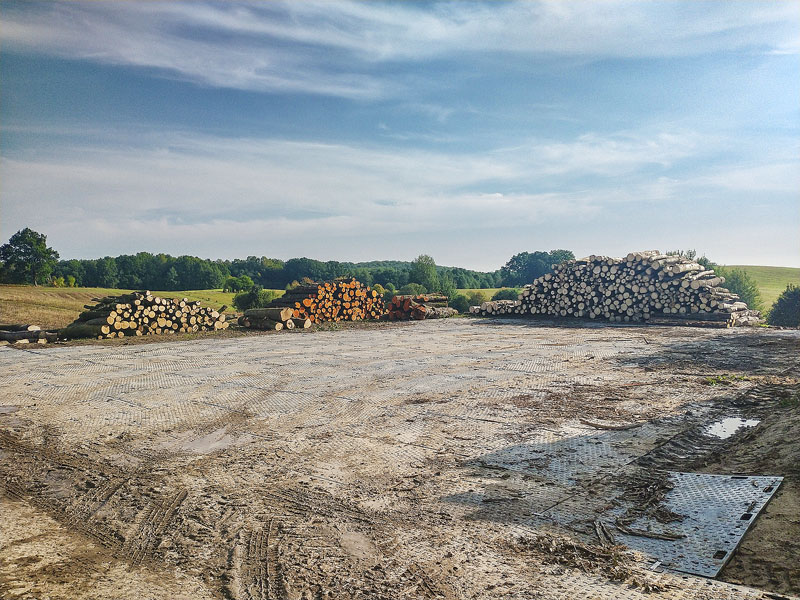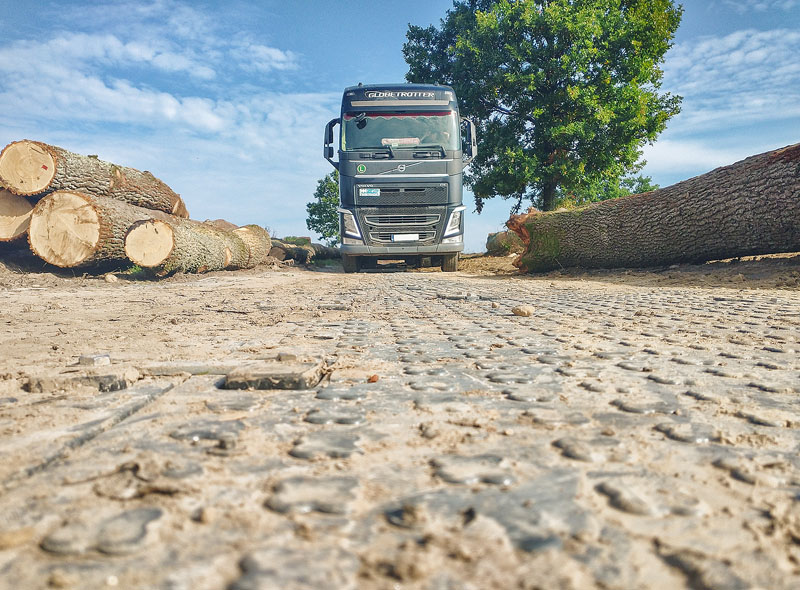While busy forest roads are easy to maintain, felling trees can already cause considerable difficulties. This is due to the need for lorries to travel along unpaved, often sandy, paths and forest roads. Particularly in autumn and spring, when rainfall is at its most intense, many forest roads become wet and thawed. Car wheels get bogged down in puddles and mud, and it takes much longer to haul away wood than it otherwise would. After such a period, it is also generally impossible to drive other than off-road vehicles.
Use of forest roads
The use of Road System road plates is quite an advantage when felling trees. The laying of the slabs can be carried out without the use of heavy equipment and the preparation of a traditional sub-base. This ensures that the terrain is not damaged or distorted! The plate road will already be laid out by teams of two fitters equipped with basic tools. No specialist knowledge or skills are required to undertake the work! Therefore, in 8 hours, a 2-person team is able to lay up to 500 metres of road with a recommended width of 3 metres! This is facilitated by the weight of the panels (27 kg or 37 kg) and the intuitive assembly.
Road System plates are manufactured from recycled plastic – the forest road is therefore paved in the most environmentally friendly way possible. The same elements can then be used to harden other areas – such as timber storage yards (their proper preparation in forests is often a difficult task). It is not only easy and quick to assemble, but also to dismantle the panels!

Use of forest roads – key principles
Paving during felling is not the only reason why forestry district employees use forest roads. From time to time, they also take an inventory of the state of the forest and refresh the forest road markings. During this time they are moving motor vehicles. Even then, however, general rules on the use of forest roads apply to employees carrying out official activities. These include:
- prohibition of littering in the area,
- overtaking,
- use of acoustic signals.
Very often, driving on forest roads is only allowed at a limited speed – this can be as low as 30 km/h. On some sections of forest roads, there is a total ban on vehicle traffic – not only by car, but also by moped or motorised cart traffic (of course, these restrictions in this case do not apply to Forestry Commission employees performing official duties). You can always check these and other road-specific rules on the Forestry Commission’s notice board. Information about possible dangers (e.g. fire) or works in progress can be found there.
But how does one even know which roads are actually forest roads? This is evident from their labelling and definitions.
The proper marking of forest roads is the responsibility of the Forestry Commission, which is usually the road manager. And only such marked roads may be used by private cars! A forest road itself, on the other hand, is one that is in the forest and is not a public road.
It is also worth knowing that all information on forest management and the assessment of its condition is contained in special documents, i.e. simplified forest management plans.
Forest road access
In the forested areas there are roads frequented only by residents commuting to their properties. Such a forest road can also be made available for public traffic. How to do it? This shall be decided by the competent forestry manager after taking into account the principles of nature conservation and forest management. This will make the use of the forest road more widely available, not only for those carrying out official activities (i.e. employees of the forestry division).
Making a forest road available for use involves preparing it appropriately – especially if no paving measures have been undertaken on the designated forest area so far, for example. In this situation, roads that are not public roads can either be paved in a time-consuming, traditional way or a modern solution can be used. All you need to do (especially temporarily!) is lay out the Road System road plates on the forest road! This will make the forest roads made available to traffic much more user and environmentally friendly. The road slabs will make it easier to pass through, while not requiring much interference with the terrain. Their quick assembly and disassembly makes them ideal for temporarily opening the road to vehicular traffic both in our own private forests and on state land.
It is often not possible to carry out an equivalent pavement structure in the forest as on public roads. In such cases, it is worthwhile to reach for other solutions that will make it easier to carry out work on forested areas and for vehicles to pass through. One of them is certainly the use of plastic road plates!
